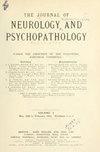Neurological Therapeutics
引用次数: 0
Abstract
I T has occasionally been said of organic diseases of the nervous system that while constituting a most interesting field of study in applied physiology and pathology, they are therapeutically destitute. An ardent neurologist might have replied that treatment in organic neurology at all times compared favourably with that in organic medical diseases, such as chronic conditions of the heart, liver and kidneys. We utter a truism in adding that all advance in knowledge of the setiology, pathology and diagnosis of a disease inevitably leads to increased understanding of the possible means of treatment. It is to these aspects of organic disease of the nervous system that most neurological research has been directed, with many brilliant results. Nevertheless, in reviewing the progress of neurology during recent years, it is evident that increasing attention has been paid to treatment per se and that the advances have been considerable. Several diseases, formerly considered almost untreatable apart from general care and management, are now subjected to direct attack. Foremost among these is that form of progressive syphilitic meningoencephalitis, popularly though unfortunately known as ' general paralysis of the insane.' The application of malarial therapy undoubtedly inhibits the malady in the majority of early cases with the result that after a number of years, varying from two to six, the cerebrospinal fluid becomes normal, losing its increased protein content, positive Wassermann reaction and Lange curve. Patients are known among the first to be treated in this country-some 14 years ago-who still survive and in some instances remain useful members of society. An average of the available statistics indicates that approximately 35 per cent. of all cases treated-irrespective of the stage of the disease-show good and lasting remissions, while in a fair proportion of the remainder improvement or arrest of the disease occurs. Compare this with the prognosis invariably given prior to the introduction of malarial treatment神经疗法
偶尔有人说,神经系统器质性疾病虽然构成了应用生理学和病理学中最有趣的研究领域,但在治疗上却很贫乏。一位热心的神经学家可能会回答说,有机神经病学的治疗在任何时候都比有机医学疾病(如心脏、肝脏和肾脏的慢性疾病)的治疗要好。我们要说出一个不言自明的事实,即在一种疾病的分类学、病理学和诊断方面知识的一切进步都不可避免地导致对可能的治疗手段的更多了解。大多数神经学研究都是针对神经系统器质性疾病的这些方面,并取得了许多辉煌的成果。然而,回顾近年来神经学的进展,很明显,治疗本身受到越来越多的关注,并且取得了相当大的进展。有几种疾病,以前被认为除了一般护理和管理几乎无法治愈,现在却受到直接攻击。其中最主要的是进行性梅毒脑膜脑炎,通常被称为“精神病全身性麻痹”。毫无疑问,在大多数早期病例中,疟疾疗法的应用抑制了这种疾病,其结果是,若干年后,从2年到6年不等,脑脊液恢复正常,失去其增加的蛋白质含量,阳性的Wassermann反应和Lange曲线。大约14年前,在这个国家第一批接受治疗的病人中,有一些仍然活了下来,在某些情况下仍然是对社会有用的成员。现有统计数据的平均值表明,在接受治疗的所有病例中,大约35%的病例——不论疾病的阶段如何——表现出良好和持久的缓解,而其余相当比例的病例病情得到改善或控制。与此相比,在引入疟疾治疗之前总是给出的预后
本文章由计算机程序翻译,如有差异,请以英文原文为准。
求助全文
约1分钟内获得全文
求助全文

 求助内容:
求助内容: 应助结果提醒方式:
应助结果提醒方式:


